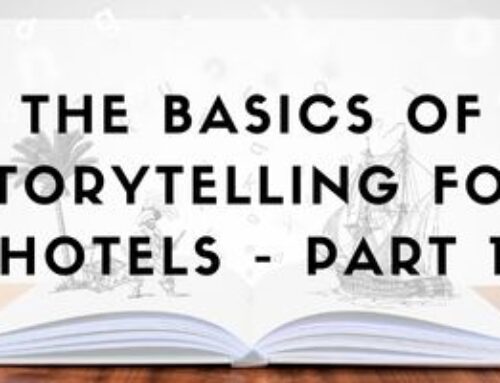
Which of your hotel’s stories do you think guests would love?
And, no, I don’t mean your property’s origin story or history…
So what should you talk about then?
In part one of this series on storytelling, we looked at how important it is to center your guest. Does that mean you should constantly talk about them?
No. Instead, tell your hotel’s stories in a way that draws people in, shows what you offer them and gets them excited to book.
If you’re not sure what to talk about, keep reading.
In part three of this series, we’ll talk about where to uncover your hotel’s stories.
Then we’ll go over how to showcase them to engage your audience and get more people to book direct.
Make your guest part of your story
We already established that storytelling doesn’t mean just sharing your company’s history or listing all your services and special offers.
This information has its place. But instead of focusing too much on yourself, let’s make the story about your hero again – your guest.
Tell your story in a way that highlights the experience guests will have with you. This lets you showcase your services and facilities and shows which needs and desires you fulfill.
That way you include your guest in your narrative from the beginning. You also make yourself more approachable and people will be more inclined to engage with you.
Where to find your hotel’s stories
Finding the right stories to tell can feel daunting. Where to start and what to highlight? Does your hotel even have any worthwhile stories to tell? I’m 100% sure it does!
Once you start looking, you’ll probably find so many, you won’t even know which one to share first.
Let’s go through your property’s departments. Because yes, each one is full of stories your audience will love.
Keep one thing in mind though: all your hotel’s stories should follow your overall style and theme. That creates a consistent experience for potential guests and differentiates you from the competition.
Let’s get started.
Front office & rooms
Your front office team makes the first impression on people when they arrive. Throughout the stay, it’s your guest’s primary point of contact.
There’s bound to be some good stories to tell there…
Start by looking at your property and its design. How does it connect your hotel to local surroundings, history or culture? Did you work with a local design and architecture firm? Or are you located in a historical building with a cool backstory? Who are your neighbors? Perhaps you can create a link to them.
Next, think about the feeling your lobby/entrance area evokes. Does it inspire a sense of grandeur and luxury? Or rather the feeling of entering a cozy space where guests feel at home? Let your tone and style reflect this feeling.
Then consider how you welcome guests. What sets your check-in process apart from the standard procedure of ID checks and key handovers? A simple gesture can make a huge difference. For example, the DoubleTree by Hilton brand offers every guest a warm chocolate chip cookie on arrival. Talk about a warm welcome 🍪
This signature service gives them something fun to talk about on their website, social media and even media communication. They even shared the recipe and made a video to show how to bake the cookie at home. This led to countless media outlets, food and travel bloggers picking up the press release and resharing it.
Finally, think about your team. Your head concierge, porters or housekeepers must have some interesting stories to share. Profile team members regularly to make your hotel more approachable and personal. It gives guests the chance to get to know you and the team even before they arrive.
Food & beverage
The most common story to tell in F&B is your chef’s. Introduce them, their background and what makes their cooking stand out. It could be their dedication to local dishes, sourcing only organic ingredients or creating a whole new fusion cuisine. Tie this in with your overarching theme to keep your narrative consistent.
The Seehotel Überfahrt in southern Germany does this well. Their chef has been with the hotel for years and has earned three Micheline stars. He champions a modern version of traditional German food and emphasizes local specialties. Of course, he’s the face of the restaurant and many guests come specifically to meet him.
Of course, think of the rest of your team as well. Perhaps your restaurant manager or sommelier have an intriguing backstory or a wealth of experience to share. Remember, if you give your business a face, it’s easier to build a personal connection with potential guests.
Spa & recreation
The spa and recreation departments address your guest’s deep desires for relaxation, enjoyment, discovery and fun. Of course, there’s fantastic potential to find more of your hotel’s stories here…
Your spa’s design and theme set the tone. How should your spa make guests feel? Relaxed and blissed out? Or energized and revitalized? This decides your tone and how you communicate about your spa.
Next, look at your treatments. Which teachings are they inspired by? Do you offer popular options like Thai massage and aromatherapy? Or perhaps your wellness services are centered around Ayurveda?
The Hôtel Le Saint-Rémy in France does a nice job introducing their unique treatment style, highlighting its benefits and tying it into the hotel’s overall services.
What’s the secret to drawing in potential guests, and getting them to book?
Get access to my free video training now, if you want to…
… learn how to leverage the power of storytelling and personal branding at your hotel to drive more direct bookings and keep more of your revenue!
By entering your details, you get access to sporadic newsletter-style emails about all things hospitality copywriting, including products and services I think you might like. You can unsubscribe anytime. I will protect your information in accordance with my privacy policy.
Let’s get to work: Ideas for how to tell your hotel’s stories
Now that we’ve looked at the basics of storytelling, how to address your target market, and where to find your hotel’s stories, it’s time to get to work.
Below, you’ll find ideas for boosting your storytelling throughout your online and media presence.
Telling your hotel’s stories on your hotel website
This is your hotel’s online business card. Leverage it to create the impression you want, draw in your target audience and get them to book.
Follow these four steps for better storytelling on your hotel website:
- Show how you address your audience’s needs and desires when you present your property. Instead of just listing facts (e.g., room count, opening hours, type of facilities…) highlight the benefits. Think: how does this aspect add value to your guest’s stay?
- Make your site easy to navigate. Briefly introduce your various departments on the home page and add links to supporting information pages. The intro serves both as a sign that you offer a specific service and as a teaser that piques people’s interest.
- Make your visuals and texts work together. Do your images tell your story? Are they in line with your overall theme, tone and style? Or are they generic stock photos 🥱
- Step up your visual storytelling with a video or a 360-degree virtual tour. This immersive experience helps guests picture themselves at your property and allows you to showcase your best side once more.
Here are two good examples by Best Western and Banyan Tree. Notice how they both create an emotional response but in quite different ways and with different target markets.
Google also did a good job with the clip below. Yes, a video or virtual tour requires time and money. A simple approach is good for starters though. You can always step it up later.
Telling your hotel’s stories on your social media
Since you can share content as often as you want, every post is a new chance to tell more of your story. That makes social media a great way to stay in touch with your existing audience and get in front of new people.
But social media is good for more than just showcasing your services. It’s also a way to give people behind the scenes insights into your operations.
Think: short, creative or funny videos that show how you provide amazing service. You could also introduce team members and highlight how they create great guest experiences.
Instagram Stories or Reels and TikTok are great for that because they’re easier and cheaper to produce than a brand video. The impact can be equally strong though.
Finally, as you work on refining and sharing your story, always remember: you must be able to deliver what your story promises. If you overpromise and underdeliver, your guests will be disappointed, leave bad reviews and your reputation will suffer.
Instead, your story should set and manage expectations. Then your clients will be delighted from the moment they find out about you.
Aaaaand that concludes the three-part series on storytelling 👏
Now that you’ve gone through all three articles and have inspiration for refining your storytelling, it’s time to get to work.
Test your new ideas, play around with different formats, get the word out about your offering and get ready for your ideal guests to flock to you!
What’s the secret to drawing in potential guests, and getting them to book?
Get access to my free video training now, if you want to…
… learn how to leverage the power of storytelling and personal branding at your hotel to drive more direct bookings and keep more of your revenue!
By entering your details, you get access to sporadic newsletter-style emails about all things hospitality copywriting, including products and services I think you might like. You can unsubscribe anytime. I will protect your information in accordance with my privacy policy.







Leave A Comment